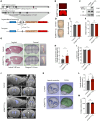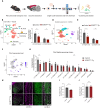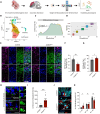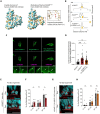Perturbed cell fate decision by schizophrenia-associated AS3MTd2d3 isoform during corticogenesis
- PMID: 40153497
- PMCID: PMC11952104
- DOI: 10.1126/sciadv.adp8271
Perturbed cell fate decision by schizophrenia-associated AS3MTd2d3 isoform during corticogenesis
Abstract
The neurodevelopmental theory of schizophrenia emphasizes early brain development in its etiology. Genome-wide association studies have linked schizophrenia to genetic variations of AS3MT (arsenite methyltransferase) gene, particularly the increased expression of AS3MTd2d3 isoform. To investigate the biological basis of this association with schizophrenia pathophysiology, we established a transgenic mouse model (AS3MTd2d3-Tg) ectopically expressing AS3MTd2d3 at the cortical neural stem cells. AS3MTd2d3-Tg mice exhibited enlarged ventricles and deficits in sensorimotor gating and sociability. Single-cell and single-nucleus RNA sequencing analyses of AS3MTd2d3-Tg brains revealed cell fate imbalances and altered excitatory neuron composition. AS3MTd2d3 localized to centrosome, disrupting mitotic spindle orientation and differentiation in developing neocortex and organoids, in part through NPM1 (Nucleophosmin 1). The structural analysis identified that hydrophobic residues exposed in AS3MTd2d3 are critical for its pathogenic function. Therefore, our findings may help to explain the early pathological features of schizophrenia.
Figures





Similar articles
-
A human-specific AS3MT isoform and BORCS7 are molecular risk factors in the 10q24.32 schizophrenia-associated locus.Nat Med. 2016 Jun;22(6):649-56. doi: 10.1038/nm.4096. Epub 2016 May 9. Nat Med. 2016. PMID: 27158905
-
Single molecule in situ hybridization reveals distinct localizations of schizophrenia risk-related transcripts SNX19 and AS3MT in human brain.Mol Psychiatry. 2021 Jul;26(7):3536-3547. doi: 10.1038/s41380-021-01046-9. Epub 2021 Mar 1. Mol Psychiatry. 2021. PMID: 33649454
-
Functional characterization of the schizophrenia associated gene AS3MT identifies a role in neuronal development.Am J Med Genet B Neuropsychiatr Genet. 2022 Jul;189(5):151-162. doi: 10.1002/ajmg.b.32905. Epub 2022 Jun 19. Am J Med Genet B Neuropsychiatr Genet. 2022. PMID: 35719055 Free PMC article.
-
An alternative splicing hypothesis for neuropathology of schizophrenia: evidence from studies on historical candidate genes and multi-omics data.Mol Psychiatry. 2022 Jan;27(1):95-112. doi: 10.1038/s41380-021-01037-w. Epub 2021 Mar 8. Mol Psychiatry. 2022. PMID: 33686213 Review.
-
Arsenic Methyltransferase and Methylation of Inorganic Arsenic.Biomolecules. 2020 Sep 22;10(9):1351. doi: 10.3390/biom10091351. Biomolecules. 2020. PMID: 32971865 Free PMC article. Review.
References
-
- Birnbaum R., Weinberger D. R., Genetic insights into the neurodevelopmental origins of schizophrenia. Nat. Rev. Neurosci. 18, 727–740 (2017). - PubMed
-
- Aghevli M. A., Blanchard J. J., Horan W. P., The expression and experience of emotion in schizophrenia: A study of social interactions. Psychiatry Res. 119, 261–270 (2003). - PubMed
-
- Mata I., Perez-Iglesias R., Roiz-Santiañez R., Tordesillas-Gutierrez D., Gonzalez-Mandly A., Berja A., Vazquez-Barquero J. L., Crespo-Facorro B., Additive effect of NRG1 and DISC1 genes on lateral ventricle enlargement in first episode schizophrenia. Neuroimage 53, 1016–1022 (2010). - PubMed
-
- Ripke S., O’Dushlaine C., Chambert K., Moran J. L., Kähler A. K., Akterin S., Bergen S. E., Collins A. L., Crowley J. J., Fromer M., Kim Y., Lee S. H., Magnusson P. K. E., Sanchez N., Stahl E. A., Williams S., Wray N. R., Xia K., Bettella F., Borglum A. D., Bulik-Sullivan B. K., Cormican P., Craddock N., de Leeuw C., Durmishi N., Gill M., Golimbet V., Hamshere M. L., Holmans P., Hougaard D. M., Kendler K. S., Lin K., Morris D. W., Mors O., Mortensen P. B., Neale B. M., O’Neill F. A., Owen M. J., Milovancevic M. P., Posthuma D., Powell J., Richards A. L., Riley B. P., Ruderfer D., Rujescu D., Sigurdsson E., Silagadze T., Smit A. B., Stefansson H., Steinberg S., Suvisaari J., Tosato S., Verhage M., Walters J. T., Multicenter Genetic Studies of Schizophrenia Consortium, Levinson D. F., Gejman P. V., Kendler K. S., Laurent C., Mowry B. J., O’Donovan M. C., Owen M. J., Pulver A. E., Riley B. P., Schwab S. G., Wildenauer D. B., Dudbridge F., Holmans P., Shi J., Albus M., Alexander M., Campion D., Cohen D., Dikeos D., Duan J., Eichhammer P., Godard S., Hansen M., Lerer F. B., Liang K.-Y., Maier W., Mallet J., Nertney D. A., Nestadt G., Norton N., O’Neill F. A., Papadimitriou G. N., Ribble R., Sanders A. R., Silverman J. M., Walsh D., Williams N. M., Wormley B., Psychosis Endophenotypes International Consortium, Arranz M. J., Bakker S., Bender S., Bramon E., Collier D., Crespo-Facorro B., Hall J., Iyegbe C., Jablensky A., Kahn R. S., Kalaydjieva L., Lawrie S., Lewis C. M., Lin K., Linszen D. H., Mata I., Intosh A. M., Murray R. M., Ophoff R. A., Powell J., Rujescu D., Van Os J., Walshe M., Weisbrod M., Wiersma D., Wellcome Trust Case Control Consortium 2, Donnelly P., Barroso I., Blackwell J. M., Bramon E., Brown M. A., Casas J. P., Corvin A. P., Deloukas P., Duncanson A., Jankowski J., Markus H. S., Mathew C. G., Palmer C. N. A., Plomin R., Rautanen A., Sawcer S. J., Trembath R. C., Viswanathan A. C., Wood N. W., Spencer C. C. A., Band G., Bellenguez C., Freeman C., Hellenthal G., Giannoulatou E., Pirinen M., Pearson R. D., Strange A., Su Z., Vukcevic D., Donnelly P., Langford C., Hunt S. E., Edkins S., Gwilliam R., Blackburn H., Bumpstead S. J., Dronov S., Gillman M., Gray E., Hammond N., Jayakumar A., Cann O. T. M., Liddle J., Potter S. C., Ravindrarajah R., Ricketts M., Tashakkori-Ghanbaria A., Waller M. J., Weston P., Widaa S., Whittaker P., Barroso I., Deloukas P., Mathew C. G., Blackwell J. M., Brown M. A., Corvin A. P., McCarthy M. I., Spencer C. C. A., Bramon E., Corvin A. P., O’Donovan M. C., Stefansson K., Scolnick E., Purcell S., McCarroll S. A., Sklar P., Hultman C. M., Sullivan P. F., Genome-wide association analysis identifies 13 new risk loci for schizophrenia. Nat. Genet. 45, 1150–1159 (2013). - PMC - PubMed
MeSH terms
Substances
LinkOut - more resources
Full Text Sources
Medical
Miscellaneous

